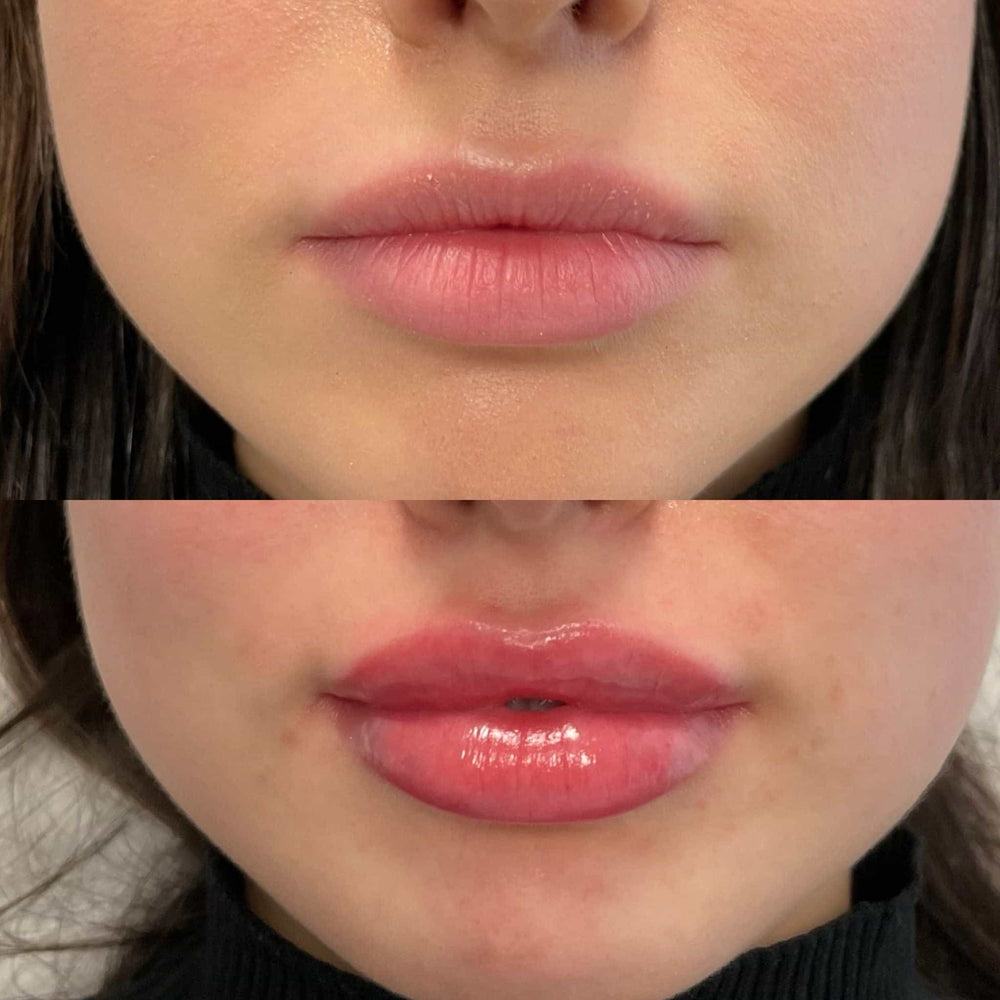Get a Dermal Filler Consultation with Dr. Laura Geige at It’s Me and You Clinic
Understanding Mentolabial Folds
Causes
Mentolabial folds, often referred to as “smile lines” or “marionette lines,” are creases that extend downwards from the corners of your mouth towards your chin.
Schedule Your Dermal Fillers with Dr. Laura Geige at It’s Me and You Clinic
They are a natural part of facial aging as skin loses elasticity and volume.
However, several factors can contribute to their appearance.
**Genetics:**
Your genes play a significant role in determining your susceptibility to developing mentolabial folds. Some individuals are genetically predisposed to having more prominent folds than others.
Facial Expressions:

Frequently smiling, frowning, or pursing your lips can contribute to the formation and deepening of these wrinkles over time.
Sun Exposure:**
UV radiation from the sun damages collagen and elastin fibers in the skin, leading to wrinkles and sagging. Protecting your face with sunscreen daily can help prevent premature aging and minimize mentolabial folds.
**Smoking:**
Smoking significantly accelerates skin aging by reducing blood flow and oxygen supply to the skin. It also damages collagen and elastin, leading to wrinkles and fine lines.
Dehydration:**
When your body is dehydrated, your skin can appear thinner and more prone to wrinkling.
Drinking plenty of water throughout the day helps maintain skin hydration and elasticity.
Arrange a Consultation for Dermal Fillers with Dr. Laura Geige Today
Common Concerns Minimizing Appearance
Mentolabial folds, also known as nasolabial folds, are creases that run from the bottom of the nose to the corners of the mouth. They are a natural part of facial aging, but some people may find them prominent and desire to minimize their appearance.
Several factors contribute to the development of mentolabial folds:
-
Facial Fat Loss:
-
Skin Elasticity Decline
-
Muscle Weakening
-
Sun Damage and Smoking
Common Concerns about Mentolabial Folds:
-
Enhancement of the appearance of aging.
-
Creating a “sad” or “downward-turned” facial expression.
-
Dimples around the mouth, making them appear deeper.
Minimizing the Appearance of Mentolabial Folds:
-
Lifestyle Changes:
-
Healthy Diet: A balanced diet rich in fruits, vegetables, and antioxidants can support skin health.
-
Hydration: Drinking plenty of water keeps the skin hydrated and plump.
-
Sun Protection: Wearing sunscreen daily and avoiding excessive sun exposure helps prevent further damage and collagen breakdown.
-
Quit Smoking: Smoking accelerates skin aging and wrinkles, including mentolabial folds.
-
Topical Treatments:
-
Retinoids: Vitamin A derivatives that can stimulate collagen production and improve skin texture. Consult a dermatologist for appropriate usage.
-
Hyaluronic Acid Serums: Can temporarily plump up the skin, making folds less noticeable.
-
Dermal Fillers: Injectable hyaluronic acid or other gel-like substances can be injected into the mentolabial folds to add volume and smooth out the crease.
-
Laser Resurfacing: Ablative lasers can remove damaged skin layers, promoting collagen production and reducing the appearance of wrinkles.
It’s important to consult with a board-certified dermatologist or plastic surgeon to discuss your concerns and determine the best treatment options for you. They can assess your individual needs and recommend personalized solutions to minimize the appearance of mentolabial folds.
Lifestyle Adjustments
Mentolabial folds, often referred to as “marionette lines” or “smile lines,” are creases that develop in the area between the corner of your mouth and the bottom of your nose. They are a natural part of the aging process, caused by a combination of factors including collagen and elastin loss, facial muscle movements, and gravity.
As we age, our skin’s supporting structures weaken, leading to sagging and the formation of folds. Repeated facial expressions like smiling, frowning, and talking also contribute to their deepening over time. Genetics can also play a role in the prominence of these lines.
While you cannot completely erase mentolabial folds, lifestyle adjustments and skincare practices can help minimize their appearance and promote skin health:
• **Protect Your Skin from Sun Damage:** Excessive sun exposure is a major contributor to collagen breakdown. Wear broad-spectrum sunscreen daily with an SPF of 30 or higher, even on cloudy days. Seek shade when possible and avoid tanning beds.
• **Maintain a Healthy Diet:** A diet rich in fruits, vegetables, lean protein, and healthy fats provides essential nutrients for skin health. Antioxidants found in colorful produce can help protect against free radical damage that contributes to aging.
• **Hydrate Adequately:** Drink plenty of water throughout the day to keep your skin hydrated and plump. Well-hydrated skin appears smoother and more resilient.
• **Quit Smoking:** Smoking accelerates collagen breakdown and damages blood vessels, impairing skin health. Quitting smoking can significantly improve skin texture and reduce the appearance of wrinkles.
• **Use Skincare Products with Retinoids:** Retinoids are vitamin A derivatives that boost collagen production and improve skin cell turnover. Consult with a dermatologist to determine the appropriate retinoid for your skin type.
• **Consider Fillers or Laser Treatments:** For more dramatic results, consult with a qualified plastic surgeon or dermatologist about fillers or laser treatments that can address mentolabial folds.
Medical Interventions
Mentolabial folds are also known as “marionette lines,” these creases that run downward from the corners of the mouth toward the chin. They are a natural part of facial aging, caused by the loss of collagen and elastin in the skin.
As we age, our skin loses its elasticity and ability to bounce back, leading to sagging and wrinkling. Gravity also plays a role, pulling down on the tissues around the mouth.
Mentolabial folds can be exacerbated by certain factors such as smoking, sun exposure, genetics, and repetitive facial expressions like frowning or smiling.
While mentolabial folds are harmless, they can become a cosmetic concern for some individuals. If you are unhappy with the appearance of your mentolabial folds, there are several medical interventions available to address them.
Fillers:
Hyaluronic acid fillers are commonly used to plump up and smooth out mentolabial folds. They work by adding volume to the area, effectively reducing the appearance of the crease.
Results from filler injections typically last for 6-18 months, depending on the type of filler used and individual factors.
Botulinum Toxin (Botox) : Botox can temporarily weaken the muscles that contribute to the formation of mentolabial folds. By relaxing these muscles, Botox can reduce the depth and prominence of the lines.
Results from Botox injections usually last for 3-4 months.
Laser Resurfacing:
Laser resurfacing treatments can stimulate collagen production and improve skin texture. This can help to minimize the appearance of mentolabial folds, but it may not completely eliminate them.
Surgical Procedures :
For more dramatic results, surgical procedures such as a facelift or neck lift may be considered. These surgeries involve removing excess skin and tightening underlying tissues, which can significantly improve the appearance of mentolabial folds and other signs of aging.
It is essential to consult with a qualified plastic surgeon or dermatologist to discuss your individual needs and goals. They can help you determine the most appropriate treatment option for you based on factors such as your age, skin type, and desired outcome.
Expert Perspectives
Dermatologist Recommendations
Mentolabial folds are those creases that run vertically between your upper lip and chin. They can be a natural part of aging as skin loses elasticity, but some people may find them more pronounced than others due to genetics or facial structure.
Experts in dermatology often recommend a multifaceted approach to addressing mentolabial folds. This usually involves a combination of lifestyle modifications, topical treatments, and potentially medical procedures.
One key recommendation is to focus on skin health through hydration and sun protection. Regularly using a moisturizer with hyaluronic acid can plump up the skin and reduce the appearance of wrinkles. Applying sunscreen daily with an SPF of 30 or higher helps prevent further collagen breakdown, which contributes to wrinkle formation.
Dermatologists may also suggest topical retinoids, vitamin C serums, or peptides as part of a skincare regimen. These ingredients can stimulate collagen production, improve skin elasticity, and reduce fine lines and wrinkles over time. It’s important to note that consistency is key with topical treatments – it takes several weeks or even months to see noticeable results.
For more dramatic improvements, dermatologists may recommend injectable fillers such as hyaluronic acid. Fillers can add volume to the area, smoothing out the folds and restoring a fuller appearance. These results are typically temporary, lasting anywhere from six months to a year.
Another option is neuromodulators like Botox. While primarily used for wrinkle reduction in the forehead and around the eyes, Botox injections can also be strategically placed in the mentolabial folds to relax the muscles that contribute to their formation.
Dermatologists will carefully assess individual needs and recommend a tailored treatment plan based on factors such as skin type, age, severity of folds, and lifestyle. It’s always best to consult with a qualified professional for personalized advice and to ensure safe and effective treatment.
Cosmetic Surgery Considerations
Menolabial folds, commonly known as nasolabial folds, are creases that run from the bottom of your nose to the corners of your mouth. They’re a natural part of aging and can deepen with time due to factors like collagen loss, sun damage, and genetics.
While there’s no guaranteed way to completely erase mentolabial folds, various treatments can minimize their appearance. Here’s what experts recommend:
- Non-Surgical Options:
-
Dermal Fillers:** Injecting hyaluronic acid fillers into the nasolabial folds can plump up the skin, smoothing out the creases. This is a relatively quick and minimally invasive procedure with results lasting 6 to 18 months.
-
Chemical Peels: These treatments use acids to remove the top layer of skin, revealing smoother skin underneath. Chemical peels can help improve the appearance of fine lines and wrinkles, including mentolabial folds. Multiple sessions may be needed for optimal results.
-
Microneedling:** This procedure involves using tiny needles to create controlled micro-injuries in the skin. This stimulates collagen production and can improve skin texture and reduce the appearance of wrinkles.
-
Laser Resurfacing: Lasers can be used to remove the outer layers of skin, stimulating collagen growth and reducing wrinkles. Different types of lasers are available, and your dermatologist can recommend the best option for you.
- Surgical Options:**
-
Facelift (Rhytidectomy):** This procedure surgically lifts and tightens the skin on the face and neck. A facelift can address sagging skin and deep wrinkles, including nasolabial folds, providing more dramatic results than non-surgical options.
Considerations Before Choosing a Treatment:
It’s crucial to consult with a qualified and experienced dermatologist or plastic surgeon to discuss your goals, expectations, and medical history. They can evaluate your individual needs and recommend the most suitable treatment options.
Factors to consider include:
-
Severity of mentolabial folds:**
-
Your budget and desired outcome:**
-
Potential risks and side effects of each treatment:**
-
Recovery time required for each option:**
Remember that every individual is different, so results may vary. It’s essential to have realistic expectations and understand the limitations of any treatment.
Andrea McGinty Art Detailed Weddings LA Create Cocktails at Home Detailed Weddings LA Crimson Hill
- Tear Trough Filler How Long To See Results - December 19, 2024
- How Do You Get Rid Of Mentolabial Folds? - December 14, 2024
- How Often Should You Get Lip Filler - December 9, 2024
